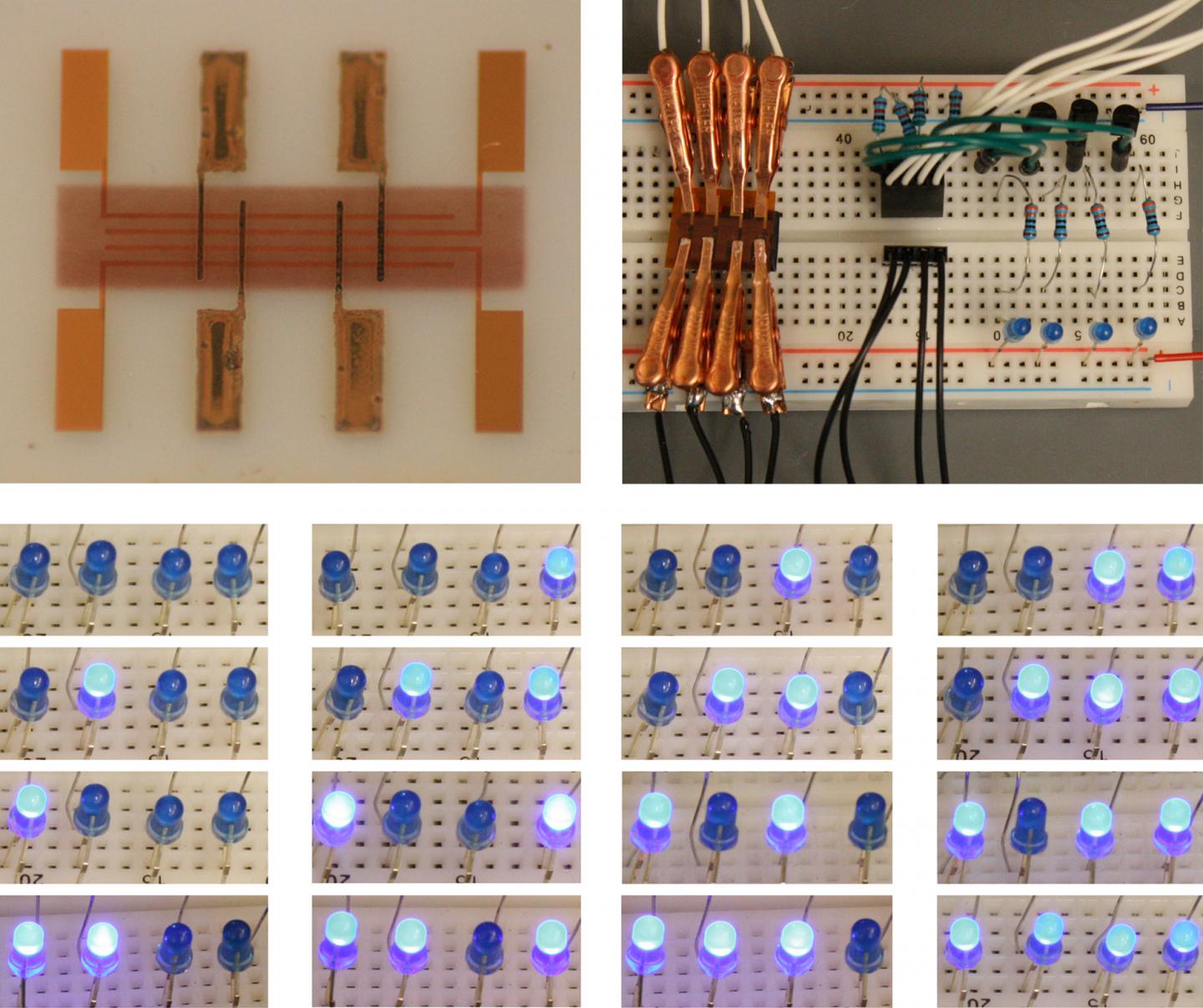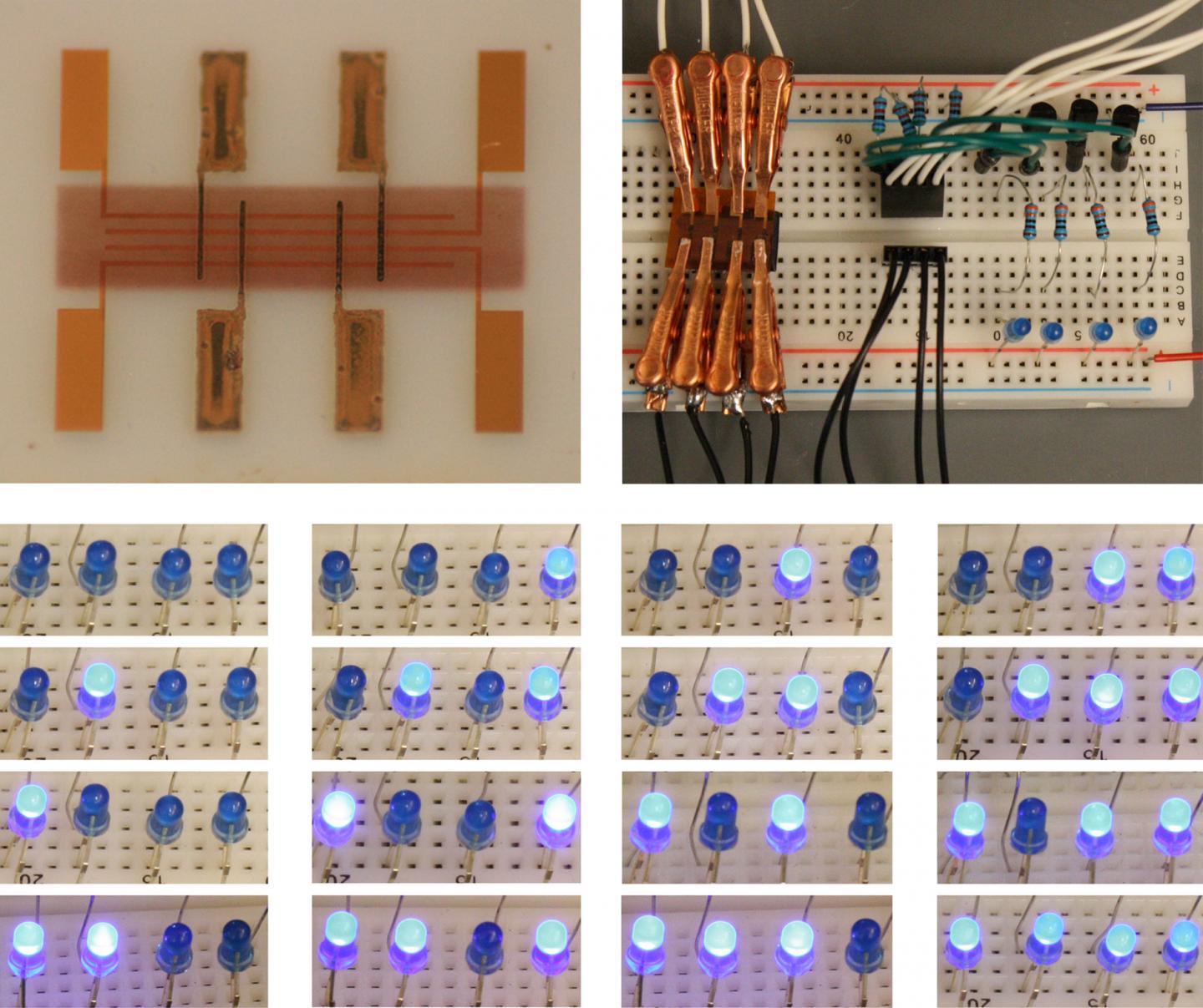
Credit: Matthew Catenacci
DURHAM, N.C. — USB flash drives are already common accessories in offices and college campuses. But thanks to the rise in printable electronics, digital storage devices like these may soon be everywhere — including on our groceries, pill bottles and even clothing.
Duke University researchers have brought us closer to a future of low-cost, flexible electronics by creating a new "spray-on" digital memory device using only an aerosol jet printer and nanoparticle inks.
The device, which is analogous to a 4-bit flash drive, is the first fully-printed digital memory that would be suitable for practical use in simple electronics such as environmental sensors or RFID tags. And because it is jet-printed at relatively low temperatures, it could be used to build programmable electronic devices on bendable materials like paper, plastic or fabric.
"We have all of the parameters that would allow this to be used for a practical application, and we've even done our own little demonstration using LEDs," said Duke graduate student Matthew Catenacci, who describes the device in a paper published online March 27 in the Journal of Electronic Materials.
At the core of the new device, which is about the size of a postage stamp, is a new copper-nanowire-based printable material that is capable of storing digital information.
"Memory is kind of an abstract thing, but essentially it is a series of ones and zeros which you can use to encode information," said Benjamin Wiley, an associate professor of chemistry at Duke and an author on the paper.
Most flash drives encode information in series of silicon transistors, which can exist in a charged state, corresponding to a "one," and an uncharged state, corresponding to a "zero," Wiley said.
The new material, made of silica-coated copper nanowires encased in a polymer matrix, encodes information not in states of charge but instead in states of resistance. By applying a small voltage, it can be switched between a state of high resistance, which stops electric current, and a state of low resistance, which allows current to flow.
And, unlike silicon, the nanowires and the polymer can be dissolved in methanol, creating a liquid that can be sprayed through the nozzle of a printer.
"We have developed a way to make the entire device printable from solution, which is what you would want if you wanted to apply it to fabrics, RFID tags, curved and flexible substrates, or substrates that can't sustain high heat," Wiley said.
To create the device, Catenacci first used commercially-available gold nanoparticle ink to print a series of gold electrodes onto a glass slide. He then printed the copper-nanowire memory material over the gold electrodes, and finally printed a second series of electrodes, this time in copper.
To demonstrate a simple application, Catenacci connected the device to a circuit containing four LED lights. "Since we have four bits, we could program sixteen different states," Catenacci said, where each "state" corresponds to a specific pattern of lights. In a real-world application, each of these states could be programmed to correspond to a number, letter, or other display symbol.
Though other research groups have fabricated similar printable memory devices in recent years, this is the first to combine key properties that are necessary for practical use. The write speed, or time it takes to switch back and forth between states, is around three microseconds, rivaling the speed of flash drives. Their tests indicate that written information may be retained for up to ten years, and the material can be re-written many times without degrading.
While these devices won't be storing digital photos or music any time soon — their memory capacity is much too small for that — they may be useful in applications where low cost and flexibility are key, the researchers say.
"For example, right now RFID tags just encode a particular produce number, and they are typically used for recording inventory," Wiley said. "But increasingly people also want to record what environment that product felt — such as, was this medicine always kept at the right temperature? One way these could be used would be to make a smarter RFID tags that could sense their environments and record the state over time."
###
This research was supported by a National Science Foundation CAREER award (DMR-1253534) and the Duke SMIF Voucher Program.
A digital version of this story is available at: https://today.duke.edu/2017/04/%E2%80%9Cspray-%E2%80%9D-memory-could-enable-bendable-digital-storage
CITATION: "Fully Printed Memristors from Cu-SiO2 Core-Shell Nanowire Composites," Matthew J. Catenacci, Patrick F. Flowers, Changyong Cao, Joseph B. Andrews, Aaron D. Franklin and Benjamin J. Wiley. Journal of Electronic Materials, March 27, 2017. DOI: 10.1007/s11664-017-5445-5
Media Contact
Kara Manke
[email protected]
919-681-8064
@DukeU
http://www.duke.edu
############
Story Source: Materials provided by Scienmag





